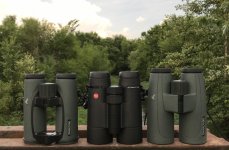When i first saw CA in binoculars, i had no idea what it was, therefore assume i wasn't 'looking for it.' I looked it up on the internet - purple/green fringing particularly.
Having been the first aberration i actually had a name for, it became the thing i subsequently looked for, or noticed almost immediately, resulting in a particularly negative response to that particular unit.
I have subsequently realised that some degree of CA can be induced in almost any optics, by really pushing the boundaries. For instance, looking at a line of distant, dark trees (at least 1km away) on a bright day at the edge of vision.
I've also found that it is more obvious in what i would call 'grey and bright' - those days of cloud cover, but reasonably high light levels.
My experience with Leica, unfortunately (as i love so much about the approach to binoculars in all other respects) has been that CA has been too obvious.
However, at Bird Fair this year, i tried the 7x42 UVHD+ and thought this was the best performer of the range in terms of control of CA. Whether this is a feature of the reduced magnification, i don't know. It instantly became my favourite Leica model.
With regard to eye position, if one has the luxury (with larger EPs or oculars) of flexibility, it seems to be possible to reduce CA, so there is some user responsibility involved before dismissing a set of bins as unacceptable, and it is apparent that users vary in their perception/acceptance of CA.
I ended up with the FL 8x32, which i still consider the champ of CA suppression.
In terms of acuity, i have measured myself at 20/15, wear glasses for reading but nothing else, and have a mild astigmatism. My eyesight is not exceptional in either direction, but there are various aberrations within optical chains i can tolerate more than i can stand obvious and easily-induced CA, for whatever reason it occurs.






